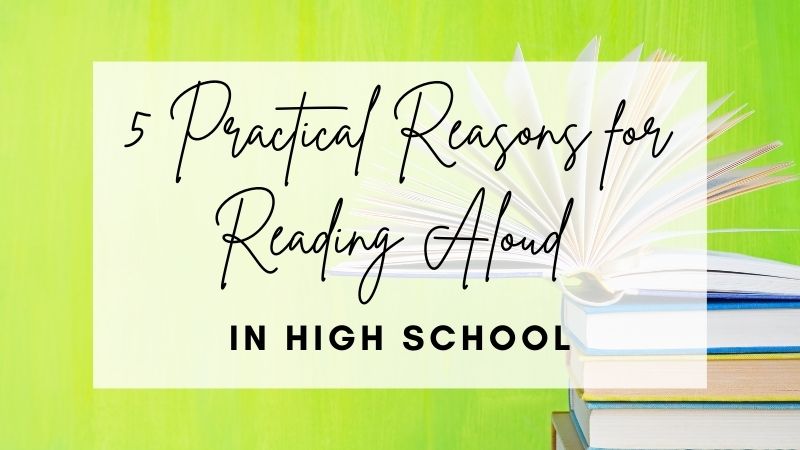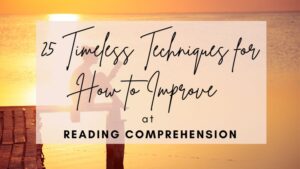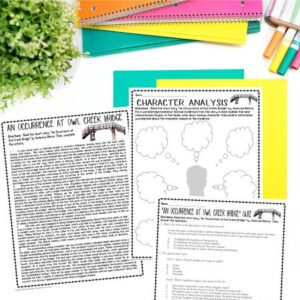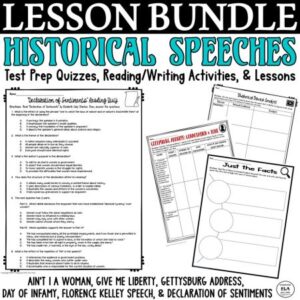By the time we got to high school, it was assumed we would have to read a lot. In science, history, and especially English, we were assigned so many chapters and books to read both inside and outside of class. So it was refreshing when a teacher began a class or started a short story by simply reading aloud.
Whether the teacher read from an inspirational magazine or joke book, it was fun to just sit and listen for the first five minutes of the class.
In our current educational environment, there are SO MANY conflicting arguments revolving around the reading process. Everyone wants students to make “progress” every year, but so often, the results of teaching reading strategies, using much-touted instructional design, and incorporating “high-interest” and “engaging” curricula are mixed at best.
Let’s go back to the basics and read with our students, especially our middle and high school students!
Keep reading for 5 Practical Reasons for Reading Aloud in High School!
Need help with Secondary Reading Test Prep? Check out this FREE Pack of 3 Test Prep Activities to help students achieve success on standardized tests!

5 Practical Reasons for Reading Aloud in High School
1. You can model good reading habits.
In a world inundated with technology, it can be tough to become a READER nowadays. I define a READER as someone who consumes fiction, nonfiction, or both on a regular basis.
Yes, most students can read to some degree, but beyond reading in school, many students simply choose not to read. There are so many other entertainment options out there from podcasts to social media scrolling to short videos. Plus, certain visual or auditory formats are so much easier to consume.
While I enjoy these forms of content as well, we cannot help our students grow in their reading habits if we are not reading ourselves.
Here are some 7 QUICK TIPS for modeling good reading habits before, during, and after reading aloud:
- Discuss the books you are reading outside of class. Let students know that readers, well, read!
- Relay why you are reading what you are reading. Is it for content, enjoyment, self-help, the future, general knowledge, etc.?
- Check out the title, cover, and summary. What do they tell us?
- Read, stop, think, and chat. I talk as I read all the time, usually with my hubby, but even myself sometimes.
- Reread. We have all gotten to that point where our minds started trailing off and we need to read a part again.
- Make connections to other things we have learned/read. When students make connections, things start to stick!
- Review what we just read before putting it down; this process can include summarizing or identifying the theme.
There are so many things good readers do as they read, and students need to see this modeled! Reading aloud can help in this process!
Want more ideas for improving reading comprehension and reading aloud? Click below!
2. You can train students to learn fluency skills.
Students need to hear fluent reading on a daily basis because comprehension increases when students can read more fluently. Reading aloud with your students, no matter the age, will aid in this goal!
If you have ever tried to read a play with your students, specifically a Shakespearean play like Romeo and Juliet or Julius Caesar, trying to get students to read fluently for various parts can be like trying to wrangle cats.
Some don’t have the stamina or ability to read longer lines. Some can read but stumble a lot through higher-level vocabulary. Some will simply refuse because they are teenagers and feel the need to rebel that day…
Playing an audio version for plays or longer texts instead of the teacher reading for 40 minutes in each class is my go-to hack.
Now, you cannot just sit at your desk and grade during that reading aloud time; students will become disengaged pretty quickly. Pausing every couple of minutes to ask questions, annotate, or fill out a graphic organizer will bring everyone back on track.
3. You can keep the class on pace/task.
There are so many different reading levels in a single high school English class, so giving students 15 minutes to read a short story like “An Occurrence At Owl Creek Bridge” or 45 minutes to read “The Most Dangerous Game” is an impossible challenge for a teacher.
You may have some students who will fly through the reading in half the time and others who will need more than double the time we think. It happens EVERY WEEK!
Reading aloud with students eliminates this issue. Everyone is on the same page at the same time, and you can teach specific skills as you read this way.
Each class can go at a different pace, but at least all of your students in the individual classes are reading together. There is nothing wrong with this.
Many stronger readers will skim ahead anyway, and that is completely fine; I did it all the time. Reading aloud gives all students the opportunity to access grade-level or higher-level texts at the same time.
4. You can help students access higher-level passages.
There are so many reasons for reading aloud higher-level literature to your students.
- If they want to go to college, they need to be able to read difficult texts like “A Modest Proposal,” “Sinners in the Hands of an Angry God,” and the Declaration of Independence. In fact, we should be reading these texts in high school no matter who our students are.
- They will be a part of the voting public, so accessing knowledge beyond the latest social media video is truly necessary.
- We want students to understand what makes good writing and quality classic literature over time.
- Our students are capable of learning beyond what we can think, even if they come to us reading 5 or more grade levels behind.
So much of our collective historical knowledge is crafted in a language that average people today cannot understand, so knowing history and reading history should be a regular part of our English instruction.
Check out these awesome, easy-to-teach resources for “A Modest Proposal!”
5. You can ensure at least some reading will be accomplished for the day.
I remember reading a statistic touted since I started my teaching career, and it goes something like this: Proficient readers read 30 minutes a day independently.
We all know that correlation does not equal causation, but many educators have twisted this statistic into a strategy called DEAR (Drop Everything And Read).
Kids who read independently for 30 minutes a day typically CHOOSE to do so, and those kids are good readers.

Letting students read whatever they want for 30 minutes a day may be a fun time for those who love reading, but for most struggling readers, it is a waste of time. They will typically choose whatever is easiest to read or something they have read before, OR they act like they are reading and accomplish nothing.
I know I am going against what many teachers have been taught, and I am fine with that. If all of your students take this time seriously, go for it.
If your students, however, are anything like mine, they need more time for reading aloud, not less!
An Argument for Reading Aloud
Our history as a society is founded on oral communication. We tell stories, share gossip, relay the news, etc. all through speaking and listening. If we try to build our students’ reading skills through independent reading alone, we do them a disservice.
When it comes to texts that have shaped the United States and the world, reading aloud is a MUST. We need to hear the words spoken and our students need to hear them as well!
Sometimes, just hearing the words allows us to think more critically, ask ourselves internal questions, and clarify major concepts. I think we can all agree that our students should have this opportunity if they are to grow as readers and citizens!
READING ALOUD RESOURCE
This Historical Speeches BUNDLE contains 80 reading comprehension QUESTIONS and ANSWERS for the texts “Ain’t I a Woman,” “Give Me Liberty,” the “Gettysburg Address,” “Declaration of Sentiments,” and “Day of Infamy” as well as ENGAGING and RIGOROUS reading and writing activities to make reading aloud and teaching these iconic speeches SIMPLE & EASY!
My goal is for test prep to become a natural and easy part of the curriculum, instead of something else you have to create. Give yourself a breath of fresh air with this NO PREP curriculum that integrates test prep within the teaching of literature!
Just PRINT & TEACH for reading aloud in high school!!
Crave more fun texts and activities for reading aloud in high school? Check out my store Kristin Menke-Integrated ELA Test Prep!






